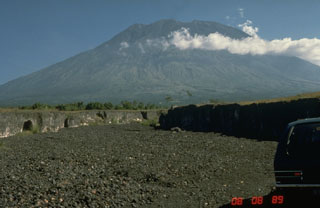Report on Agung (Indonesia) — 20 September-26 September 2017
Smithsonian Institution / US Geological Survey
Weekly Volcanic Activity Report, 20 September-26 September 2017
Managing Editor: Sally Sennert.
Please cite this report as:
Global Volcanism Program, 2017. Report on Agung (Indonesia) (Sennert, S, ed.). Weekly Volcanic Activity Report, 20 September-26 September 2017. Smithsonian Institution and US Geological Survey.
Agung
Indonesia
8.343°S, 115.508°E; summit elev. 2997 m
All times are local (unless otherwise noted)
BNPB noted that as of 1300 on 22 September there were 9,421 people displaced from the evacuation zones at Agung. Seismicity continued to increase, therefore later that day on 22 September PVMBG raised the Alert Level to 4 (the highest level on a scale of 1-4) and expanded the exclusion zone to 9 km, with an additional expansion to 12 km in the SE, S, and SW directions. On 24 September BNPB reported that the number of evacuees continued to grow, as residents were leaving the expanded evacuation zones; there were 34,931 people in 238 shelters. The report noted that some people were returning home in the daytime to feed their livestock. On 27 September the number of evacuees reached 96,086 (spread out in 430 shelters), seismic activity continued to escalate, and diffuse white plumes rose 50 m above the crater rim.
Geological Summary. Symmetrical Agung stratovolcano, Bali's highest and most sacred mountain, towers over the eastern end of the island. The volcano, whose name means "Paramount," rises above the SE rim of the Batur caldera, and the northern and southern flanks extend to the coast. The summit area extends 1.5 km E-W, with the high point on the W and a steep-walled 800-m-wide crater on the E. The Pawon cone is located low on the SE flank. Only a few eruptions dating back to the early 19th century have been recorded in historical time. The 1963-64 eruption, one of the largest in the 20th century, produced voluminous ashfall along with devastating pyroclastic flows and lahars that caused extensive damage and many fatalities.
Sources: Badan Nacional Penanggulangan Bencana (BNPB), Pusat Vulkanologi dan Mitigasi Bencana Geologi (PVMBG, also known as CVGHM)

